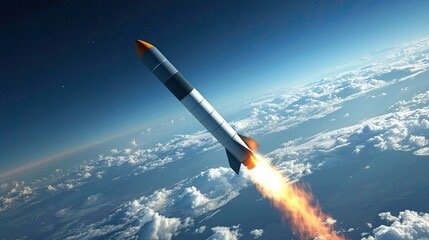WHO IS THIS FOR?
The Certified Missile Propulsion Specialist (CMPS) certification is designed for:
Military Personnel: Engineers, technicians, and operators working with missile propulsion systems in roles such as Air Force 2A6X1, Army 94T, Navy Aviation Ordnance Technicians, and Space Force missile operations roles.
Aerospace & Defense Contractors: Engineers and specialists supporting propulsion design, fuel technology, and thrust-vectoring systems in defense and government programs.
Mechanical & Aerospace Engineers: Professionals working in propulsion system development, thermodynamics, and aerodynamics related to missile and rocket systems.
Materials & Chemical Engineers: Specialists in solid and liquid propellant chemistry, combustion analysis, and fuel efficiency optimization.
Students & Early-Career Professionals: Individuals in aerospace engineering, mechanical engineering, or related fields seeking specialization in missile propulsion technology.
ELIGIBILITY
The Certified Missile Propulsion Specialist (CMPS) certification is designed for professionals working with missile propulsion systems. Ideal candidates must:
Verify they fit one of the “who is this for” categories.
Meet U.S. Export Control requirements (Must be a U.S. Person).
Be able to understand, read, and write in U.S. English without interpreters or translators.
Operate a computer for email, browsing, logging in, Zoom or similar, and other basic functions.
Own or have access to a desktop or tablet computer with internet access, a front-facing camera, and a microphone in a quiet area for completing exams.
CERTIFICATION STANDARDS
1. Missile Propulsion Fundamentals
1.1. Define missile propulsion and its role in modern defense systems.
1.2. Identify the key components of missile propulsion systems, including:
1.2.1. Combustion chambers.
1.2.2. Nozzles and thrust mechanisms.
1.2.3. Propellant storage and feed systems.
1.3. Explain the fundamental principles of thrust generation and Newton’s Third Law of Motion in propulsion.
2. Solid Propellant Rocket Motors
2.1. Describe solid rocket propulsion and its advantages in missile applications.
2.2. Explain the composition and function of solid propellants.
2.3. Identify key factors affecting burn rate, thrust variation, and motor performance.
2.4. Discuss thrust-vector control methods used in solid rocket motors.
3. Liquid Propellant Rocket Engines
3.1. Define liquid propulsion and its use in missile systems.
3.2. Compare monopropellant and bipropellant propulsion systems.
3.3. Describe cryogenic and hypergolic fuel types used in missile propulsion.
3.4. Explain injector design and combustion chamber optimization for efficiency.
3.5. Discuss engine throttling and restart capabilities in liquid propulsion.
4. Hybrid Propulsion Systems
4.1. Define hybrid propulsion and its advantages over solid and liquid systems.
4.2. Describe the structure and operational principles of hybrid rocket engines.
4.3. Identify propellant combinations used in hybrid missile applications.
4.4. Discuss challenges in hybrid propulsion, including combustion stability.
5. Thrust Vector Control (TVC) and Guidance
5.1. Explain the principles of thrust-vector control in missile maneuverability.
5.2. Compare TVC mechanisms, including:
5.2.1. Gimbaled nozzles.
5.2.2. Jet vanes and grid fins.
5.2.3. Electromagnetic thrust-vectoring technologies.
5.3. Discuss how TVC interacts with missile guidance systems for precision targeting.
6. Propulsion System Integration and Optimization
6.1. Describe the integration of propulsion systems within the overall missile structure.
6.2. Identify methods for optimizing fuel efficiency and burn rates.
6.3. Explain cooling and insulation techniques for missile propulsion components.
6.4. Discuss trade-offs between thrust, weight, and range in missile propulsion design.
7. Environmental and Safety Considerations
7.1. Identify safety hazards in handling missile propellants.
7.2. Explain storage and transportation requirements for missile fuel types.
7.3. Discuss environmental regulations and concerns related to missile propulsion.
8. Advanced and Emerging Propulsion Technologies
8.1. Explore next-generation missile propulsion technologies, including:
8.1.1. Scramjet and ramjet propulsion.
8.1.2. Electromagnetic and plasma-based propulsion systems.
8.2. Discuss the role of AI and machine learning in propulsion optimization.
8.3. Identify trends in missile propulsion research for increased efficiency and precision.
RELEVANT MILITARY JOB CODES
The Certified Missile Propulsion Specialist (CMPS) certification aligns with military roles specializing in missile propulsion, rocket engine maintenance, and guided weapons systems. Relevant military job codes include:
2A6X1 – Air Force Aerospace Propulsion Technician
2M0X1 – Air Force Missile and Space Systems Electronic Maintenance
94T – Army Avenger System Repairer (missile propulsion & control)
94P – Army Multiple Launch Rocket System (MLRS) Repairer
Navy Aviation Ordnance Technicians (AO) – Focus on missile propulsion and warhead integration
Space Force Missile Propulsion & Rocket Systems Roles
Aerospace & Defense Engineers in Missile Propulsion Development
This certification is also valuable for engineers, technicians, and defense contractors working in missile propulsion system design, optimization, and integration.
